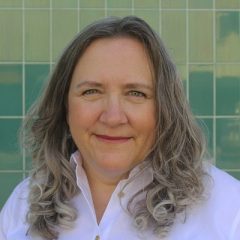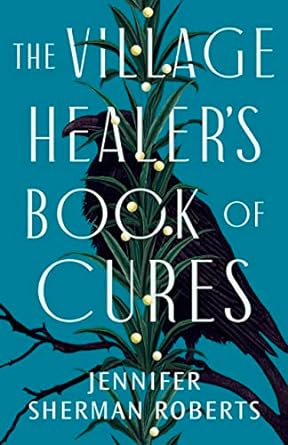 Southern Oregon writer Jennifer Sherman Roberts holds a PhD in Renaissance literature from the University of Minnesota, as well as master’s and bachelor’s degrees from Villanova University and the University of California, Berkeley. She is also a facilitator for Oregon Humanities, leading community conversations on the topic “Conspiracy Theories: Truth, Facts, and Tinfoil Hats” She has also taught at southern Oregon University and worked as the Interim Executive director of Josephine Community Libraries Inc. She lives in Grants Pass, where she is a debut novelist, fierce library advocate, occasional knitter, and aspiring mead maker.
Southern Oregon writer Jennifer Sherman Roberts holds a PhD in Renaissance literature from the University of Minnesota, as well as master’s and bachelor’s degrees from Villanova University and the University of California, Berkeley. She is also a facilitator for Oregon Humanities, leading community conversations on the topic “Conspiracy Theories: Truth, Facts, and Tinfoil Hats” She has also taught at southern Oregon University and worked as the Interim Executive director of Josephine Community Libraries Inc. She lives in Grants Pass, where she is a debut novelist, fierce library advocate, occasional knitter, and aspiring mead maker.
Her debut novel, The Village Healers Book of Cures, is in seventeenth-century England, is her debut novel. Based on actual witch hunt in England, it’s a surprisingly modern tale of murder, revenge, alchemy, and evil.
Ed Battistella: I really enjoyed the Village Healer’s Book of Cures. How did you come up with the idea?
Jennifer Sherman Roberts: Oh, I’m so glad you enjoyed it!
The idea for the novel sort of crystalized when I was doing a conversation project with Oregon Humanities called “Stone Soup: How Recipes Can Preserve History and Nourish Community.” We were discussing a seventeenth-century healing recipe for “The Biting of a Mad Dogge” that required crabapple be harvested at a certain time of year, and one of the participants pointed out that it sounded sort of witchy. That gelled in my mind with a blog post I was writing about Witchfinder General Matthew Hopkins, et voila!
EB: There were several nice plot twists, including one involving the smarmy witch hunter Matthew Hopkins. That character was based on a real person, I understand.
JSR: Yes, and a horrible one at that. Though there have been many witch hunts and many witchfinders, he is probably the most notorious, having written a witchfinding manual called “The Discovery of Witches.” He began hunting witches in his hometown of Manningtree in England when, according to his own account, he overheard women talking about meeting the Devil in the forest. Witch-hunting became a profitable trade for him, as towns would levy a hefty tax for his services.
The method he used most for “discovering” witches was the pricking test. It was thought that witches had a “witch’s mark” (often considered a third nipple used to suckle the Devil) that would not bleed when pricked, so these poor women were poked all over with pins, needles, and even daggers.
By the time he ended his witchfinding career, Hopkins was responsible for the death of 300 women.
EB: Each chapter starts off with a brief recipe for curing some ailment, like dried mistletoe for convulsions or powdered goats blood mixed with ale for kidney stones. When I got to the end of the book, you answered the burning question I had, whether these were real historic cures or one’s you made up. Where did the recipes come from?
JSR: I found the recipes in digitized collections ranging from the Folger Shakespeare Library in DC to the Wellcome Library in London. They’re all open access, so anybody can read them. The handwriting can be difficult, though, so I also looked at an online research project for transcribing the recipes called “Shakespeare’s World.”
EB: Have you tried any of them? Have modern researchers looked into this?
JSR: Oh, heavens no, not by me! I have a healthy respect for the potency of herbs and would only want somebody with a whole lot of experience and training to make them. Lots of researchers have duplicated food recipes though, and the results are fun and delicious. I once made a “hedgehog pudding” with my kids—I was horrified when I saw the name of the recipe, but then I read on and realized it wasn’t made from hedgehogs but rather was a pleasant kind of vanilla pudding molded into the shape of a hedgehog with toasted almonds for the prickly bits.
EB: There were several nice turns of phrasing in the book, like the earlier use of the term “cunning woman?” Did your academic training give you an ear for the earlier language?
 JSR: It’s funny you should mention that, as the book was originally titled “The Cunning Woman’s Book of Receipts” (changed because another book was recently published had too similar a name). As I hope I described well enough in the book, cunning women were healers, advice-givers, and dealers in small charms. I’ve read a lot about cunning women and how they played so many roles in the community, and yet came under such suspicion.
JSR: It’s funny you should mention that, as the book was originally titled “The Cunning Woman’s Book of Receipts” (changed because another book was recently published had too similar a name). As I hope I described well enough in the book, cunning women were healers, advice-givers, and dealers in small charms. I’ve read a lot about cunning women and how they played so many roles in the community, and yet came under such suspicion.
Having read so much from the period, I think I have an easier time replicating the cadence and rhythms of 17th century English. As a novelist, though, I have to be careful that it doesn’t sound too stilted to a modern reader. That’s why, for example, I use contractions in the novel. To be absolutely faithful to the language of the time would mean pulling the reader out of the story. It’s a fine balance and a bit of a dance doing both.
Where I think my research most affected my language–where I was able to let the formality take over–was in the trial of Agnes Shepherd. I had read so many transcripts of which trials that Hopkins’s accusations and 17th-century legalese came more naturally.
EB: More generally, what was the research like for the book?
JSR: Oh, I loved the research: The history of the English civil war, humoral medical theory, the use of medicinals and herbals, and as much as I could absorb about everyday life in a small 17th century village. I also read a ton about witches (particularly Owen Davies’s amazing work) and alchemy.
I’d written some blog posts about these recipes for the academic blog The Recipes Project. I’m fascinated by how the recipe books from that period are a jumble of food, perfume, and medical cookery. We’ve separated and codified each of those areas in the modern world, and seeing them side by side, I think, leads one to thinking of the ways these discrete areas intertwine.
I’m fascinated, too, by how the recipes seem to resemble some alchemical instructions and healing potions while presaging modern chemistry. I thought about that continuum while writing Mary, who has a deep thirst to know about the efficacy of her cures.
EB: One of the things that struck me early on was your comment that healers are motivated by wanting to understand as well as to cure. I had never though of their motivation that way. How did that realization come to you?
JSR: My take may be modern, and it may be that I’m imposing that thirst to discover the causes of things on my characters, but I don’t think so. The novel is set during the beginning of the Scientific Revolution, after all—not long after Francis Bacon famously called a new way of understanding knowledge. I think that drive to understand can’t have just been exclusive to the elite and aristocratic. I figured surely a woman hunting for herbs and cooking for long hours would want to know whether—and why—they worked.
The medical ideas that had been circulating for centuries—especially of the four humors (yellow bile, black bile, phlegm, and blood) —point to a desire to understand the fundamental working of these materials in the body, and indeed the recipes reference phlegm, blood, and bile. We have lots of evidence that men were thinking in these ways, but since almost all women were forbidden to circulate their own ideas in writing, we can’t share their thinking as easily. I guess this is my way of imagining what it must have been like.
EB: Is there a moral of the tale for today’s readers?
JSR: Oh, that’s a great question. The novel grapples with the fear of knowledge and the prejudices that are allowed to possess communities. Of charlatans and villains and cowards. But it also, I hope, explores the many varieties of love and belonging. Personally, I think there are a lot of parallels with scientific, political, and cultural controversies happening now—not least of which is a recasting of the phrase “witch hunt.”
But I leave that up to the reader.
EB: If you were casting this story as a movie, who would you get to play Mary?
JSR: Oh, I’ve had a running cast in my head since the beginning! For Mary, I’ve imagined Emilia Clarke (of Games of Thrones/ Daenerys Targaryen fame). I’ve also imagined Fiona Shaw as Agnes.
EB: Have you got plans to bring Mary Fawcett and Robert Sudbury back for another book?
JSR: I’m not sure. There’s definitely more to their story, and there are characters in the novel I’d love to explore more. We’ll have to see what the demand is, I guess!
EB: Thanks for talking with us. Best of luck with The Village Healer’s Book of Recipes?
JSR: It’s been a pleasure. Thanks so much!

 Follow
Follow